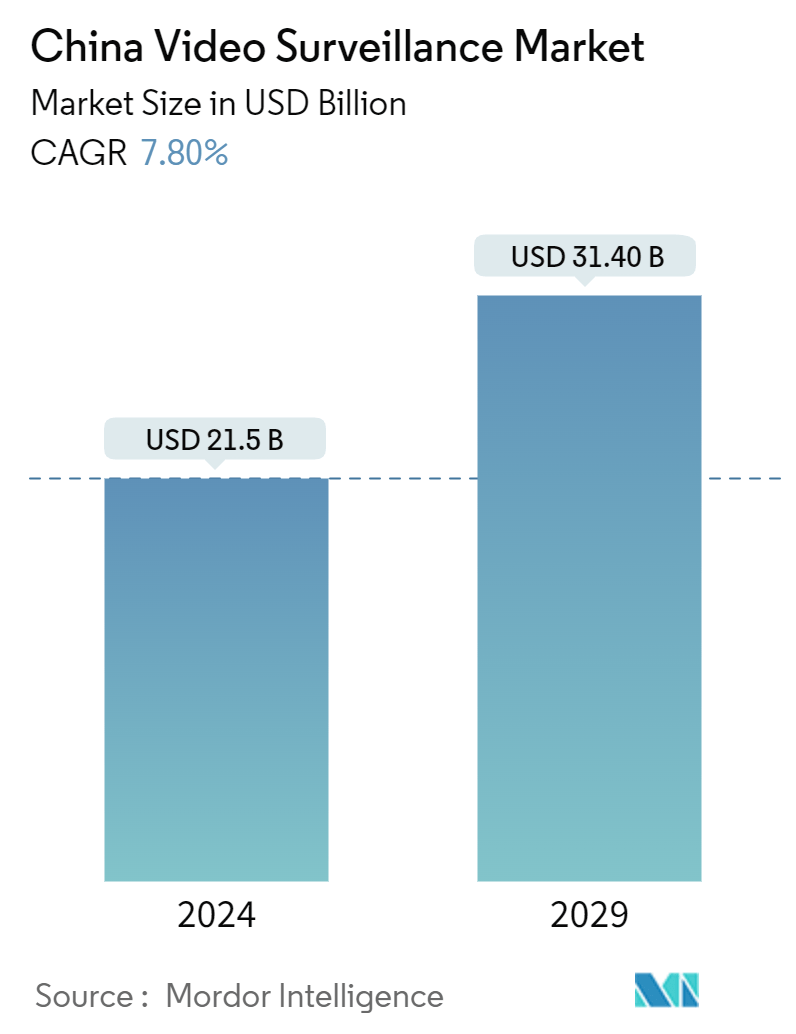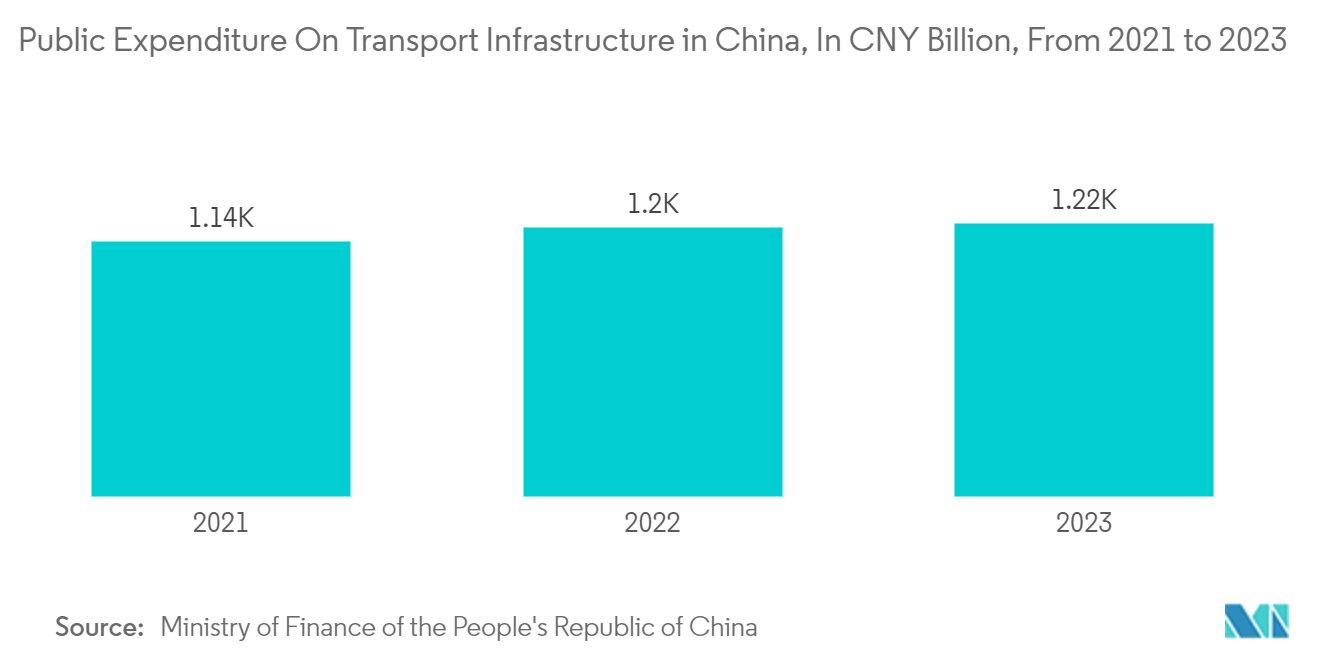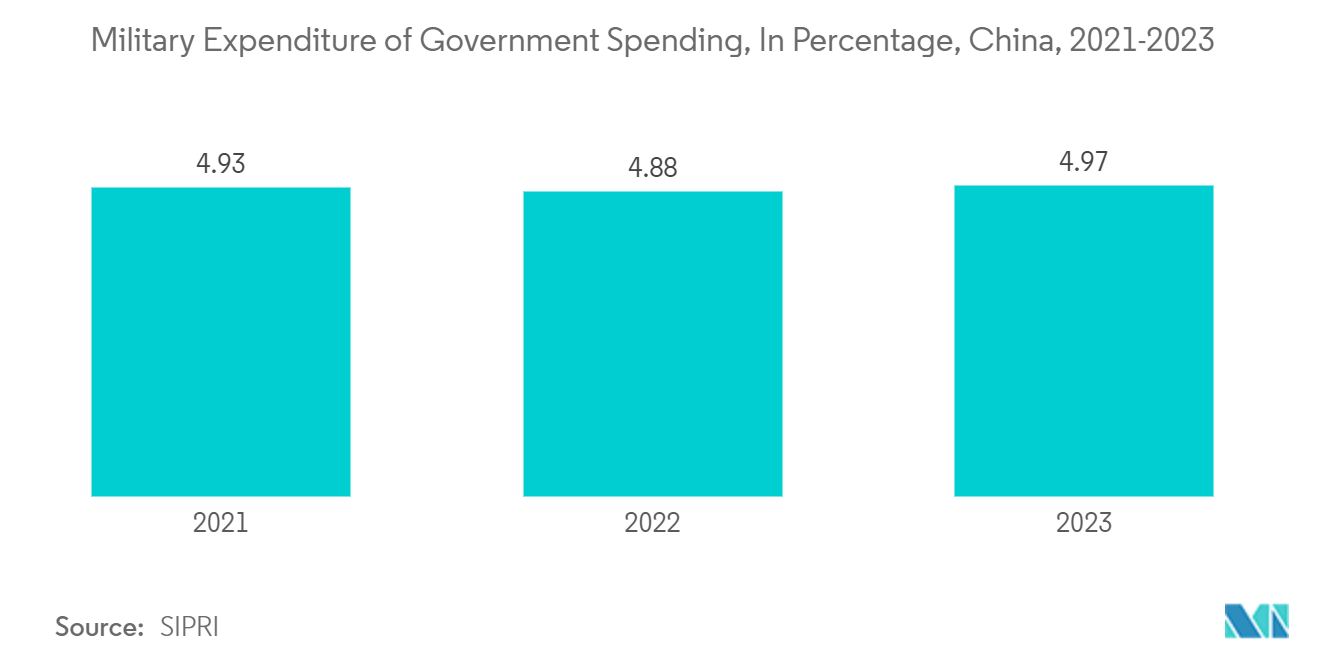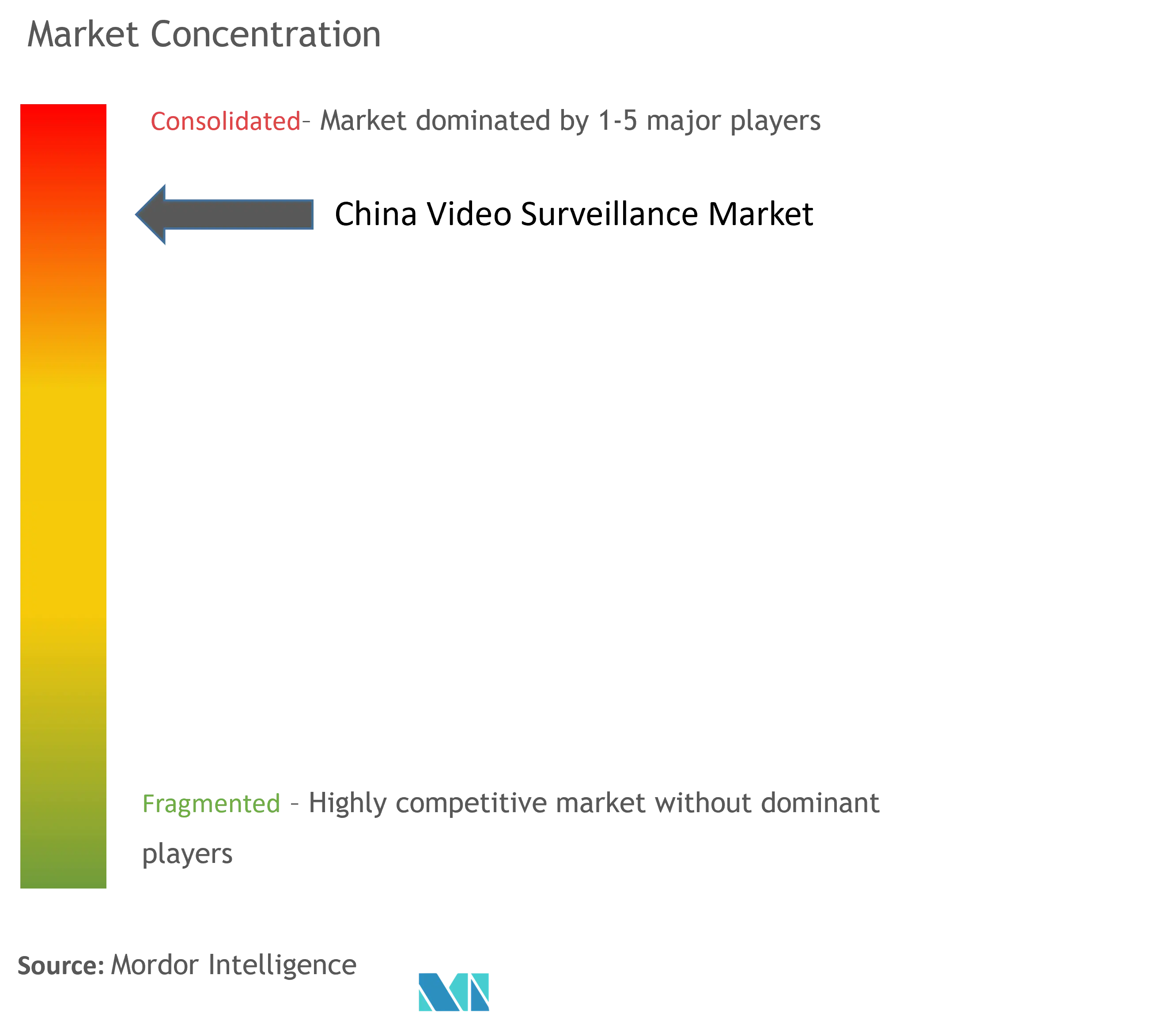China Video Surveillance Market Size

| Study Period | 2019 - 2029 |
| Base Year For Estimation | 2023 |
| Market Size (2024) | USD 21.5 Billion |
| Market Size (2029) | USD 31.40 Billion |
| CAGR (2024 - 2029) | 7.80 % |
| Market Concentration | High |
Major Players
*Disclaimer: Major Players sorted in no particular order |
China Video Surveillance Market Analysis
The China Video Surveillance Market size is estimated at USD 21.5 billion in 2024, and is expected to reach USD 31.40 billion by 2029, growing at a CAGR of 7.80% during the forecast period (2024-2029).
- China has undergone rapid urbanization and infrastructure development, leading to the construction of new cities and the expansion of existing ones. This has created a demand for advanced video surveillance systems to monitor public spaces, transportation networks, and critical infrastructure.
- The country has over 700 million surveillance cameras, one lens for every two citizens. These cameras identify an individual by their body movement through facial recognition or gait recognition technologies. In addition, according to the Australian Strategic Policy Institute and the non-governmental research partner, the Chinese public generally approves of the widespread use of surveillance technologies. On a scale of 10, most respondents rated their trust in central government positively at an average of 7.3. Regarding video, audio, or Internet surveillance, the business received a rating of 6.7. This type of approval for video surveillance by its people nationwide attracts market growth.
- Further, the Chinese government has actively promoted the development and implementation of video surveillance systems as part of its broader strategy to enhance public safety and maintain social stability. Government initiatives such as the Golden Shield project, Safe Cities, SkyNet, Smart Cities, and Sharp Eyes program have led to increased investment in video surveillance technology.
- Moreover, the advancements in video surveillance technologies have played a significant role in the market's growth. Chinese companies have been at the forefront of developing and deploying these technologies, making them more accessible and affordable. For instance, integrating video surveillance with artificial intelligence (AI) and big data analytics has expanded the capabilities of these systems. AI-powered video analytics can automatically detect and analyze suspicious activities, identify individuals, and generate real-time alerts, enhancing the effectiveness of video surveillance in various applications.
- Further, China has a robust domestic video surveillance industry, with several prominent companies leading the market. According to the report from RFE/RL, Dahua and Hikvision, two Chinese companies have become the world's leading providers of closed-circuit television and surveillance systems, dominating markets in Hungary, Serbia, Romania, Moldova, Ukraine, Bosnia-Herzegovina, Kosovo, Bulgaria, and Georgia. Their competitive pricing, technological expertise, and strong government support have contributed to the market's growth.
- However, the extensive collection and storage of personal data through video surveillance systems raise concerns about data privacy and security. In addition, the use of advanced technologies, such as facial recognition, raises ethical concerns regarding surveillance and potential misuse. According to IPVM, Dahua, a Chinese manufacturer of surveillance equipment, sells cameras with a "skin color analysis" function in Europe. Human rights and civil liberties concerns arise as regards the identification of skin color in surveillance applications. These types of incidences may hinder the market growth during the projected period.
China Video Surveillance Market Trends
The IP Camera Segment Is Expected to Hold Significant Share
- An IP or internet protocol camera is a digital security camera that receives and sends video footage via the IP network. They are ubiquitous for surveillance. IP cameras do not require a local recording device; only with the help of a regional network can it work. An IP security camera can transmit the footage over the wireless network. In particular, IP cameras use Wi-Fi, an Ethernet cable, or USB to connect to a network video recorder (NVR).
- The continuous advancements in various industry verticals, such as institutional, infrastructure, commercial, and residential sectors, are rapidly evolving. These industries rely on highly advanced surveillance cameras to protect their assets and ensure the safety of their customers. In addition, the country is witnessing aggressive investments in infrastructure development. For instance, according to the Ministry of Finance of the People's Republic of China, in 2023, the country invested a total public expenditure of about CNY 1.22 trillion (USD 0.17 trillion) on transport infrastructure.
- Owing to the flexibility of the IP camera, it can be easily deployed and repositioned in various scenarios within an infrastructure building. Additionally, as IP cameras operate on a network, additional cameras can be added to the system without significant infrastructure modifications, making it easier to expand surveillance coverage.
- Further, IP cameras can be integrated into broader Internet of Things (IoT) ecosystems and smart home systems, enhancing their functionality and interoperability. Integration with IoT devices and platforms enables automation, data sharing, and enhanced control over the surveillance system, providing users with a more comprehensive and connected security solution.
- In addition, the rise of cloud-based video surveillance solutions has facilitated the rise of cloud computing. IP cameras can be connected to cloud platforms, enabling secure storage, remote access, and advanced analytics capabilities. Cloud-based solutions offer scalability, flexibility, and cost-effectiveness to various customers, making them appealing.

Defense End-user Vertical Is Expected To Hold Significant Share
- As a significant global power, China highly emphasizes national security, which includes safeguarding its borders, critical infrastructure, and public safety. Video surveillance meets these security priorities by providing real-time monitoring, threat detection, and evidence collection capabilities.
- Further, China has one of the world's most enormous defense budgets, enabling significant investments in advanced technologies and equipment. This financial support has allowed the defense industry to develop and deploy sophisticated video surveillance solutions tailored to defense applications, such as border control, military installations, and sensitive government facilities. According to SIPRI, the Chinese government has increased its defense spending by 4.97%, which will help technological advancements.
- Moreover, defense-related video surveillance systems require robust data protection mechanisms to safeguard sensitive information. The defense industry's expertise in cybersecurity and encryption technologies ensures that video surveillance data remains secure and protected from unauthorized access. These systems complement and synergize with other defense technologies like radar, drones, and biometrics. The integration of these technologies enhances overall defense capabilities, providing comprehensive situational awareness and threat detection.
- The defense industry in China benefits from solid research and development capabilities, with dedicated institutions and organizations focusing on developing cutting-edge technologies. For instance, video surveillance systems, including unmanned aerial vehicles (UAVs) equipped with cameras, are used for intelligence gathering, reconnaissance, and surveillance missions. These systems provide real-time video feeds and imagery for situational awareness, target identification, and mission planning. These capabilities contribute to creating advanced video surveillance solutions that meet the specific demands of defense applications.

China Video Surveillance Industry Overview
The Chinese video surveillance market is consolidated with two significant global players with dominant positions. The market players emphasize partnerships, mergers, acquisitions, and innovations by investing in research and development to remain competitive and dominant. In addition, Chinese vendors Hikvision and Dahua dominate the supply of video surveillance products in China. Some of the key players in the market include Hangzhou Hikvision Digital Technology Co. Ltd, Dahua Technology Co. Ltd, Uniview Technologies Co. Ltd, Sunell Technology Corporation, and The Infinova Group.
April 2024: Hikvision announced its latest Turbo HD range of analog security devices. The Turbo HD 8.0 provides users with a more complete and engaging security experience, enabling them to improve their image safety environment. Four significant innovations have been introduced in the Turbo HD 8.0, bringing users real-time communication, 180-degree video protection, and raising night vision to a new height. The enhancements extend the range of Turbo HD products with two-way audio capabilities, compact dual-lens cameras with stitching technology, and Smart Hybrid Light capability across the entire range of Turbo HD cameras.
March 2024: Dahua Technology launched the X-Spans series, a new camera unit combining panoramic scene overview with PTZ and tracking capabilities. The company‘s latest range includes operating in combined mode, where panoramic and detail sensors collaborate for smart tracking, and independent mode, where the channels function separately with different AI functions. This configuration allows for efficient coverage of the larger areas and view angles, potentially reducing the need to add more cameras or cables and providing a cost-effective monitoring solution in each location.
China Video Surveillance Market Leaders
-
Hangzhou Hikvision Digital Technology Co., Ltd.
-
Dahua Technology Co., Ltd
-
Uniview Technologies Co., Ltd.
-
Sunell Technology Corporation
-
The Infinova Group
*Disclaimer: Major Players sorted in no particular order

China Video Surveillance Market News
- March 2024: After using the success of its giant video surveillance network, Skynet, China planned to put all observations on the Moon in place for a system that it claims will guarantee security at its future base on the Moon. Skynet will inform us of how they built and operated the optical surveillance system for China’s lunar research station.
- January 2024: The Hong Kong government announced plans to install 2,000 CCTV cameras in public places as part of the fight against crime. The government would consult the Office of the Privacy Commissioner to protect personal data. The Deputy Chief Secretary mentioned that a new series of surveillance cameras would be deployed in densely populated areas or at high crime sites. It will strengthen its district management using this initiative.
China Video Surveillance Market Report - Table of Contents
1. INTRODUCTION
1.1 Study Assumptions and Market Definition
1.2 Scope of the Study
2. RESEARCH METHODOLOGY
3. EXECUTIVE SUMMARY
4. MARKET INSIGHTS
4.1 Market Overview
4.2 Industry Attractiveness - Porter's Five Forces Analysis
4.2.1 Threat of New Entrants
4.2.2 Bargaining Power of Buyers
4.2.3 Bargaining Power of Suppliers
4.2.4 Threat of Substitute Products
4.2.5 Intensity of Competitive Rivalry
4.3 Industry Value Chain Analysis
4.4 Technology Snapshot
4.5 Impact of Macro Trends on the Market
5. MARKET DYNAMICS
5.1 Market Drivers
5.1.1 Increasing Need to Enhance Safety and Security in the Country
5.1.2 Rapid Growth in Technologies such as Software that Integrated AI
5.2 Market Restraint
5.2.1 Increasing Privacy and Human Rights Violation Concerns
6. MARKET SEGMENTATION
6.1 By Type
6.1.1 Hardware
6.1.1.1 Camera
6.1.1.1.1 Analog
6.1.1.1.2 IP Camera
6.1.1.1.3 Hybrid
6.1.1.2 Storage
6.1.2 Software
6.1.2.1 Video Analytics
6.1.2.2 Video Management Software
6.1.3 Services (VSaaS)
6.2 By End-User Verticals
6.2.1 Commercial
6.2.2 Infrastructure
6.2.3 Institutional
6.2.4 Industrial
6.2.5 Defense
6.2.6 Residential
7. COMPETITIVE LANDSCAPE
7.1 Company Profiles*
7.1.1 Hangzhou Hikvision Digital Technology Co. Ltd
7.1.2 Dahua Technology Co. Ltd
7.1.3 Uniview Technologies Co. Ltd
7.1.4 Tiandy Technologies Co. Ltd
7.1.5 Sunell Technology Corporation
7.1.6 The Infinova Group
7.1.7 Qognify Inc. (Hexagon)
7.1.8 Axis Communications AB
7.1.9 Sony Corporation
7.1.10 Shenzhen TVT Digital Technology Co. Ltd
8. INVESTMENT ANALYSIS
9. FUTURE OF THE MARKET
China Video Surveillance Industry Segmentation
A video surveillance system comprises a network of cameras, monitors, display units, and recording devices. Analog or digital cameras can be used with various features such as resolution, frame rate, and color type. The purpose of the cameras is to deter illegal behavior, and video footage may also be used as evidence for future review by security personnel or law enforcement officers. Most video surveillance systems are designed to be secure so that signals can not be transmitted to unauthorized persons.
The Chinese video surveillance market is segmented by type (hardware [camera [analog, IP camera, and hybrid], storage), software [video analytics and video management software], and services [VSaaS]) and end-user verticals (commercial, infrastructure, institutional, industrial, defense, and residential). The report offers market size and forecasts for all the above segments in value (USD).
| By Type | ||||||||
| ||||||||
| ||||||||
| Services (VSaaS) |
| By End-User Verticals | |
| Commercial | |
| Infrastructure | |
| Institutional | |
| Industrial | |
| Defense | |
| Residential |
China Video Surveillance Market Research FAQs
How big is the China Video Surveillance Market?
The China Video Surveillance Market size is expected to reach USD 21.5 billion in 2024 and grow at a CAGR of 7.80% to reach USD 31.40 billion by 2029.
What is the current China Video Surveillance Market size?
In 2024, the China Video Surveillance Market size is expected to reach USD 21.5 billion.
Who are the key players in China Video Surveillance Market?
Hangzhou Hikvision Digital Technology Co., Ltd., Dahua Technology Co., Ltd, Uniview Technologies Co., Ltd., Sunell Technology Corporation and The Infinova Group are the major companies operating in the China Video Surveillance Market.
What years does this China Video Surveillance Market cover, and what was the market size in 2023?
In 2023, the China Video Surveillance Market size was estimated at USD 19.82 billion. The report covers the China Video Surveillance Market historical market size for years: 2019, 2020, 2021, 2022 and 2023. The report also forecasts the China Video Surveillance Market size for years: 2024, 2025, 2026, 2027, 2028 and 2029.
China Video Surveillance Industry Report
Statistics for the 2024 China Video Surveillance market share, size and revenue growth rate, created by Mordor Intelligence™ Industry Reports. China Video Surveillance analysis includes a market forecast outlook for 2024 to 2029 and historical overview. Get a sample of this industry analysis as a free report PDF download.



